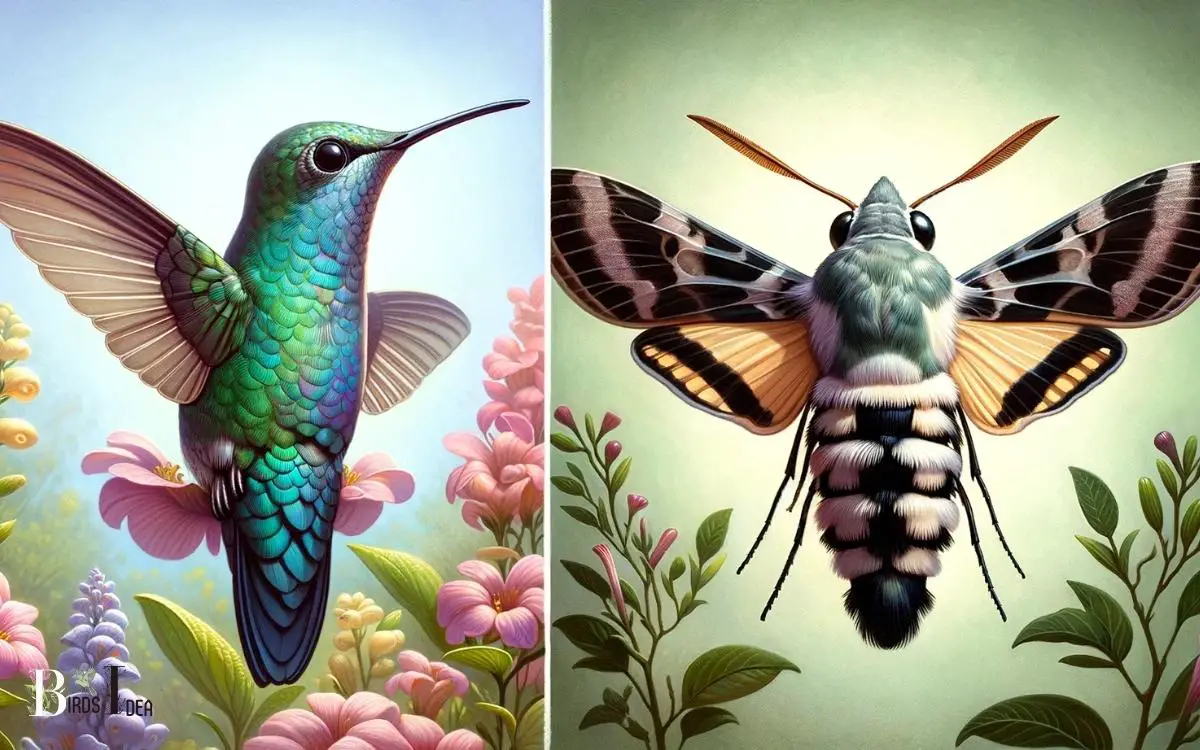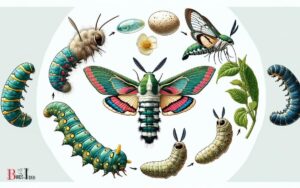Difference Between Hummingbird and Hummingbird Moth!
The difference between a hummingbird and a hummingbird moth may not be immediately obvious to the casual observer.
These remarkable creatures share similar traits that can make them appear quite alike at first glance, but upon closer inspection, their distinctions become clear.
While both display remarkable hovering abilities and feed on nectar, their biological classifications and behaviors set them apart.
Understanding these differences can provide a deeper appreciation for the diversity of the natural world.

Key Takeaway
Physical Characteristics
The hummingbird and hummingbird moth both share a striking resemblance in physical characteristics, but they can be differentiated by their size and wing structure.
Hummingbirds are typically small birds, ranging from 3 to 5 inches in length. They’ve vibrant, iridescent feathers and a unique ability to hover in mid-air while feeding.
Their wings beat rapidly in a figure-eight pattern, allowing them to move with incredible agility.
On the other hand, hummingbird moths are larger, with a wingspan of 1.6 to 1.8 inches. They’ve clear wings with a slight tint of color, resembling a bumblebee.
Unlike hummingbirds, they’re insects that hover like a helicopter while feeding on nectar from flowers.
These distinct differences in size and wing structure are key in telling these remarkable creatures apart.
Habitat and Distribution
The geographic ranges of hummingbirds and hummingbird moths differ significantly. Hummingbirds are primarily found in the Americas, while hummingbird moths are found in various parts of Europe, Asia, and North America.
In addition to their different ranges, these two creatures also have different preferred environments. Hummingbirds can be found in a range of habitats, from forests to deserts.
On the other hand, hummingbird moths are often found in meadows, gardens, and other areas abundant with nectar-producing flowers.
Not only do they have different habitats, but they also have different nesting habits. Hummingbirds construct unique nests in trees, shrubs, and even human-made structures.
In contrast, hummingbird moths lay their eggs on the undersides of leaves or other sheltered locations.
Geographic Ranges Differ
An interesting contrast in their geographic ranges is observed between the hummingbird and hummingbird moth.
Hummingbirds are primarily found in the Americas, from Alaska to Tierra del Fuego, and are known for their presence in a variety of habitats, including forests, deserts, and urban areas.
In contrast, hummingbird moths, also known as hawk moths, have a broader geographic range, spanning across Europe, Asia, and North America.
They’re commonly found in meadows, gardens, and other open areas with abundant nectar-producing plants.
This difference in distribution is due to the adaptability of the hummingbird moth to diverse environments, while the hummingbird’s range is limited to the Americas.
Understanding these geographic ranges provides insight into the distinct habitats and ecosystems in which these fascinating creatures thrive.
Varied Preferred Environments
Hummingbirds and hummingbird moths exhibit distinct preferences for their habitats and distributions.
- Hummingbirds are primarily found in the Americas, with the majority of species residing in Central and South America. They’re commonly found in diverse habitats such as tropical rainforests, deserts, and mountainous regions.
- Hummingbird moths, on the other hand, are more widely distributed across the globe, including regions of North America, Europe, and Asia. They’re often found in flowery meadows, gardens, and other areas abundant in nectar-producing flowers.
- Hummingbirds tend to favor areas with an abundance of nectar-producing flowers and feeders.
- Hummingbird moths, being nocturnal, are commonly found in areas with a variety of fragrant, night-blooming flowers.
- Both species exhibit adaptations to their preferred environments, ensuring their survival and successful foraging.
Unique Nesting Locations
In their nesting locations, hummingbirds and hummingbird moths exhibit distinct preferences and behaviors to ensure the survival of their offspring.
Hummingbirds typically build their nests in sheltered locations, such as the forked branches of trees or shrubs, using materials like plant fibers, moss, and lichens.
They often choose areas with an abundance of nectar-producing flowers nearby to provide a food source for their young.
In contrast, hummingbird moths prefer to lay their eggs on the undersides of leaves, where the larvae can feed on the surrounding foliage.
They aren’t selective about the type of plant and may choose anything from garden plants to wildflowers.
Additionally, hummingbird moths are found in a wider range of habitats, including meadows, gardens, and even urban areas, compared to the more specific habitat preferences of hummingbirds.
Feeding Behavior
Both the hummingbird and the hummingbird moth exhibit fascinating feeding behaviors.
Their nectar feeding methods, pollination roles, and preferred flower types offer intriguing points of comparison.
Understanding these distinctions sheds light on the unique ecological roles of these remarkable creatures.
Nectar Feeding Methods
The nectar feeding methods of hummingbirds and hummingbird moths are both characterized by their efficient use of long tongues to extract nectar from flowers.
Hummingbirds have specialized tongues that can extend beyond the length of their bills, allowing them to reach deep into flowers to access nectar.
Hummingbird moths, on the other hand, have long proboscises that they use to probe into the flowers to extract nectar.
Both hummingbirds and hummingbird moths have the ability to hover in front of flowers while feeding, thanks to their rapid wing beats and precise flight control.
Hummingbirds and hummingbird moths are known for their agility and maneuverability, enabling them to access nectar from a wide variety of flower shapes and sizes.
Both species play a crucial role in pollination as they transfer pollen from one flower to another while feeding on nectar.
Pollination Role Differences
Hummingbird’s feeding behavior facilitates pollination through their efficient nectar extraction methods.
As they visit flowers to feed on nectar, their long, slender bills and specialized tongues allow them to reach deep into the flower, brushing against the reproductive structures and picking up pollen.
When they visit the next flower, some of this pollen is transferred, facilitating the fertilization of plants.
On the other hand, the hummingbird moth, with its long proboscis, also feeds on nectar but lacks the same efficiency in pollination.
While they inadvertently pick up some pollen, they don’t have the same deliberate and effective pollination role as hummingbirds.
Therefore, while both contribute to pollination to some extent, the hummingbird’s feeding behavior is more directly linked to efficient pollination.
Preferred Flower Types
Feeding on a variety of flowers, hummingbirds and hummingbird moths demonstrate differences in their preferred flower types, influencing their foraging behaviors and roles in pollination.
Hummingbirds are attracted to brightly colored flowers, particularly red, orange, or pink ones. They’re especially drawn to tubular flowers that hold nectar at the base, suited to their long, slender bills.
On the other hand, hummingbird moths favor flowers with a strong, sweet scent, such as jasmine, honeysuckle, or phlox.
They’re also known to feed on a wide range of flowers, including tubular ones and those with shallow nectar reservoirs.
Both species play key roles in pollination, but their distinct flower preferences lead to varying foraging behaviors.
Life Cycle and Reproduction
During mating season, both hummingbirds and hummingbird moths seek out suitable locations for laying their eggs. The life cycle and reproduction of hummingbirds and hummingbird moths differ significantly.
Hummingbirds typically build small cup-shaped nests using plant materials, spider silk, and other natural elements, while hummingbird moths lay their eggs on the undersides of leaves.
The table below summarizes the key differences in the life cycle and reproduction of hummingbirds and hummingbird moths.
| Aspect | Hummingbirds | Hummingbird Moths |
|---|---|---|
| Nesting Behavior | Build cup-shaped nests | Lay eggs on undersides of leaves |
| Incubation Period | 14-16 days | 8-10 days |
| Offspring | Hatch as helpless chicks | Hatch as caterpillars |
| Mating Behavior | Male displays to attract female | Male releases pheromones to attract female |
Flight Patterns
Both hummingbirds and hummingbird moths exhibit distinct flight patterns, enabling them to efficiently navigate their environments.
- Both species are capable of hovering in mid-air, allowing them to feed on nectar from flowers with precision.
- They can swiftly change direction, darting from one flower to another or evading predators with agility.
- Hummingbirds and hummingbird moths are known for their ability to fly backward, a rare skill in the animal kingdom that aids them in accessing hard-to-reach nectar sources.
- Their flight patterns often involve rapid wingbeats, allowing them to maintain stability and control in the air.
- Both species are adept at executing quick and intricate aerial maneuvers, showcasing their remarkable flight capabilities.
These unique flight patterns contribute to the distinctive behavior and ecological roles of hummingbirds and hummingbird moths in their respective ecosystems.
What are the main differences between a hummingbird and a hummingbird moth?
The main differences between a hummingbird and a hummingbird moth bird insect lie in their biology. While both have similar appearance and behaviors, the hummingbird is a bird, and the hummingbird moth is an insect. Additionally, the moth has antennae and lays eggs, while the bird does not.
Predators and Threats
Exhibiting remarkable flight capabilities, both hummingbirds and hummingbird moths face threats from various predators in their ecosystems.
Hummingbirds, known for their agility and speed, are vulnerable to predators such as cats, snakes, and larger birds like hawks and owls.
These predators target hummingbirds while they’re resting or feeding on nectar, making them susceptible to surprise attacks.
Additionally, hummingbird nests are at risk of being raided by squirrels, raccoons, and other small mammals.
On the other hand, hummingbird moths, with their similar appearance to hummingbirds, also face threats from predators like spiders, mantises, and birds.
Their survival depends on their ability to evade these predators while foraging for nectar and laying eggs.
Both species have evolved various strategies to minimize their exposure to these threats and ensure their survival in their respective habitats.
Conclusion
Both the hummingbird and the hummingbird moth are magnificent creatures, each with their own unique physical characteristics, feeding behaviors, and flight patterns.While the hummingbird is a feathered flyer, the hummingbird moth is a furry imitator.
Despite their differences, both face predators and threats in their habitats.These tiny titans truly tantalize the senses and teach us to treasure the delicate balance of nature.






